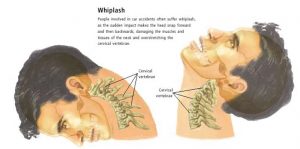Sport Rehabilitation and Physiotherapy for Whiplash

What is Whiplash?
Whiplash occurs when your head is suddenly jolted backwards and forwards in a whip-like action. This can cause the muscles and ligaments to stretch beyond their normal limit. Damage to the spinal cord can occur from a severe whiplash but is very uncommon and not dealt with in this article.
What causes Whiplash?
The common cause is when a car is hit mostly from behind but can occur when hit from other directions. Less commonly it can occur with everyday activities such as jolting the neck when you trip or fall.
What are the symptoms of Whiplash?
Pain and stiffness in the neck which may take several hours to appear. Moving the neck may be difficult and you may feel pain or stiffness in the upper back, shoulders and arms. Dizziness, headache, blurred vision or pain on swallowing may occur for a short while but please visit your GP if any of these persist. Some people become irritable and find it difficult to concentrate. Very occasionally you may get lower back pain and symptoms referring into the legs.
What treatments are most commonly used for Whiplash?
When a whiplash injury occurs the neck muscles spasm as a protective mechanism so it is important for your therapist to relax these muscles.
Massage – Encompassing a variety of techniques and is given with sufficient pressure through the superficial tissue to reach the deep lying structures. It is used to increase blood flow, decrease swelling, reduce muscle spasm and promote normal tissue repair.
Mobilisation – Is a manual technique where the joint and soft tissues are gently moved by the therapist to restore normal range, lubricate joint surfaces, and relieve pain.
Ultrasonic therapy – Transmits sound waves through the tissues stimulating the body’s chemical reactions and therefore healing process, just as shaking a test tube in the laboratory speeds up a chemical reaction.
Manipulation – Is a high speed, short movement thrust given at the end of available range. It is used to break down adhesions, remove a blockage within a joint and restore full painless movement. A click or noise may be experienced during this treatment.
Interferential therapy – Introduces a small electrical current into the tissues and can be used at varying frequencies for differing treatment effects. E.g. pain relief, muscle or nerve stimulation, promoting blood flow and reducing inflammation.
What other treatments could be used for Whiplash?
Acupuncture – An oriental technique of introducing needles into the skin to increase or decrease energy flow to promote pain relief and healing.
What can you do yourself to help Whiplash?
Exercise programme – This is the most important part of the rehabilitation. Your therapist will instruct you as to which exercises to begin with, when to add the others, as well as how to progress the exercises.
Medication – Ask your GP or Pharmacist for advice on the best medication for your condition.
Heat packs – A hot pack may be beneficial in helping the muscles to relax, promote blood flow to the area and provide pain relief.
Posture – Good posture enables the muscles of the spine to act as a supporting structure and decreases the strain on the spine.
Ergonomics – Ensure all your seating is encouraging good posture and your mattress is supporting your spine adequately.
What if treatment does not help or resolve Whiplash?
It is extremely rare that therapy does not give great benefit. In these cases we would refer you on for further investigation.
If you think you may have this condition we would love the opportunity to show you our expertise in the treatment and management of this condition so – Please click here for details of how to contact us to book an appointment
If you are unsure whether you have this condition or you would just like to speak to somebody then please get in touch here or call 0161 745 7551.
